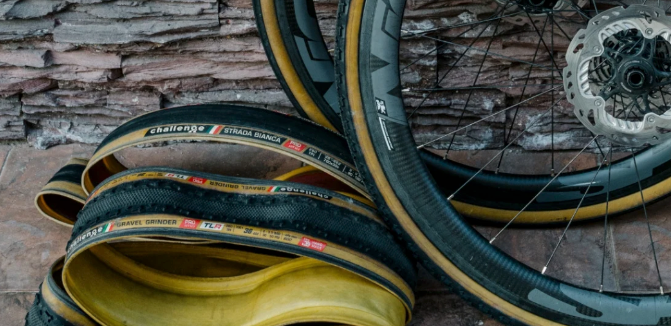Gravel Tires – What You Should Know!
It is well known that gravel bikes have conquered cities, trails, and everything in between. It has also spread that a gravel bike needs the right tires to meet the diverse purposes. It is no secret that there is now a wide selection of gravel tires. But how do you find the right tire for your gravel bike?
Here you will learn everything you need to know about gravel tires. For example, which tire sizes fit a gravel bike. Or which tire tread suits your plans. And whether puncture-resistant tires are important to you. And so on. By the way, today people mostly talk about the “bicycle tire,” but it is also not wrong to continue calling this bike part bicycle casing .
What Tire Size Fits Your Gravel Bike?
Basically, there are three sizes on a gravel bike – as with any other bicycle – that you need to consider when choosing tires.
- There is the wheel size. It indicates the diameter of the wheel. Usually, on gravel bikes, this is 28 inches (equivalent to 622mm). Less commonly, there are 27.5 (584mm) or 29 inches.
- There is also the tire width. On gravel, tires between 32 to 55mm in width are mounted, depending on the purpose.
- Both together are the tire size you need to buy for your gravel.

On gravel bikes, 28-inch wheels are particularly common, with tire widths between 32 and 50mm. Images © Pirelli
To start, let's find out which tires actually fit your gravel bike:
How Much Tire Clearance Does Your Gravel Bike Have?
To buy the right tires for your gravel bike, you need to know which tire width and diameter fit into your bike frame.
|
Every bike has a manufacturer-recommended tire clearance (or in English “clearance” or “tire clearance”). The tire clearance tells you how wide tires can be so they can spin freely in the rear triangle and fork. Additionally, every bike is built for a specific wheel size. |
So you can only ride wheels of one size on most bikes – including gravel bikes – but you can mount tires of different widths.
Some bikes also offer the option to mount wheels in different sizes. This works, for example, with the “Terra” gravel bikes from Orbea . If your gravel bike has this option, you can find out in the section "What sizes are available for gravel tires?" how the tires affect the riding characteristics, and choose which riding characteristics are important to you. For a bike that does not offer this option, you must decide when purchasing the bike.
|
If you do not find any information in the product description or manual of your gravel bike, the 4mm minimum distance from the tire to the frame is considered a rule of thumb. |
In what size are gravel tires measured?
Choosing the right bicycle tire is unfortunately a bit complicated, as there are different units of measurement for wheels, tubes, and bicycle tires, namely French sizes, English sizes (in inches) and ETRTO or ISO sizes.
Often you do not have to deal with multiple sizes when searching for the right bicycle tires, as certain tire sizes have become standard depending on the type of bicycle. On racing bikes, French tire sizes are often found, on MTB they are often measured in inches/ or English tire sizes and trekking bikes and city bikes usually have ETRTO sizes (or ISO) specified.
As if that wasn't complicated enough, the matter is unfortunately made even more confusing by the different approaches to measuring tires . While the outer diameter is measured for inches and French tire sizes, the ETRTO specification calculates with the inner diameter at the tire bead. But there are tables that help you compare sizes.
Which tire size for which bicycle?
- French sizes → Racing bike
- ETRTO size specifications → Trekking bikes and city bikes
- Tire sizes in inches → Mountain bikes
For gravel bike tires, the trend is toward French tire sizes. But since the purpose of the gravel bike covers the intersection of all bicycles, you may have to deal with all three size systems when looking for the right gravel tires.
- If you mainly ride your gravel bike in the city , you may end up buying all-weather tires with an ETRTO specification.
- If you want to ride off-road , tires from the MTB range in inches may be the right ones.
- If you are looking for a nimble rolling behavior for fast rides on asphalt , you will deal with racing bike tires and French tire sizes.
|
Often (but not always), gravel bikes are equated with road bikes when it comes to tires. Therefore, you often find the French tire sizes as manufacturer information for the tire clearance of a gravel bike or as size information on the tires themselves. |
Since they are often found on gravel bikes, here is a quick explanation of the French tire sizes - they consist of the following measurements:
|
approximate outer diameter |
x tire width |
General NOTE ON TIRE HEIGHT; A, B, or C |
A common tire size on a gravel bike would be 700x35C, so the tire has about 700mm (70cm) outer diameter, 35 mm width, and C corresponds to about 39mm.
What sizes are available for gravel tires?
There are different wheel sizes on the bike, but most gravel bikes ride on one of two possible sizes, they have 28-inch wheels or 27.5-inch wheels. This also makes the selection of suitable tires much easier.
The diameter of the wheels
Gravel bikes, thanks to their road bike heritage, mostly have 28-inch wheels, but there are also 27.5 or 29-inch diameters (i.e., particularly thick 28-inch tires). Depending on what your frame allows, the appropriate wheels must be mounted and tires in these sizes fitted.
The wheel sizes for gravel bikes as a table
|
27.5-inch wheels |
28-inch wheels |
|
|
ETRTO |
… -584 |
… -622 |
|
Inch/inch |
27.5x… |
28x… |
|
French |
650x… |
700x… |
(the dots here replace the tire width)
What impact does wheel size have on a gravel bike?
In the world of off-road bikes, wheel sizes have been hotly debated for years, sometimes smaller tires are considered better, then only large tires are ridden. If you can't decide at all, you buy a bike with a mullet setup, i.e., two different tires at the back and front, or a frame that offers the possibility to mount different tire sizes. But which tire is better on a gravel bike?
Larger tires on a gravel bike?
Large tires (or better: large wheels) are always good for optimal traction on gravel, so if you want to cover distance, and do it quickly, you should opt for larger tires. The steering may feel a bit more sluggish with larger wheels, but the bike holds its course better, it runs more stably overall. When you're off-road, it can be quite interesting that large wheels roll over obstacles better than small ones.
Smaller tires on a gravel bike?
Smaller wheels not only make your gravel bike more maneuverable, they also accelerate faster. However, efficiency on the track decreases slightly. Smaller wheels offer another option: depending on the allowed clearance, you can use tires with a larger volume on smaller wheels. Such a setup offers more cushioning, better grip, and improved puncture safety.
Besides the technical advantages and disadvantages, the rider's height also plays a role in choosing the right tires for a gravel bike. Smaller frame sizes fit smaller wheel sizes, while particularly tall riders need a larger frame size and thus larger wheels.
The tire width on a gravel bike
Regardless of the wheel size, you can ride tires of different “thicknesses”. From 32 to 50mm are the common tire widths on a gravel bike, and the width has a significant impact on the bike's riding characteristics, especially on cushioning and efficiency. The susceptibility to tire punctures is also affected.
The tire width on a gravel bike as a table
|
32mm |
35mm |
37mm |
40mm |
47mm |
50mm |
|
|
ETRTO |
32-... |
35-... |
37-... |
40-... |
47-... |
50-... |
|
Inch/Zoll |
…x1.25 (or …x 1 ¼) |
…x1.35 |
…x1.40 (or … x 1 ⅜ ) |
…x1.5 (or …x1 ½ ) |
…x 1.75 |
…x 2.0 |
|
French |
…x 32B/C |
…x 35B/C |
…x 35B/C |
…x 38B/C |
…x 45C |
– |
(the dots here replace the wheel diameter)
What impact does tire width have on a gravel bike?
You directly feel the width of your gravel tires, whether you mount wider or narrower tires has an impact on the riding characteristics, comfort on the bike, and puncture susceptibility.
Wider tires on a gravel bike?
The more air in your gravel tires, the more cushioning they offer, so wide tires ride more comfortably. Wider tires also have more surface on the road, providing more traction and grip. On the other hand, you exert more effort to overcome rolling resistance when more tire surface “sticks” to the road. Lastly, wide tires are naturally heavier.
Narrow tires on a gravel bike?
If you're in a hurry, you should opt for narrower tires, less rolling resistance, less weight, and excellent efficiency are the clear advantages here. However, the bike loses off-road capability as the tire width decreases. The narrower the tires, the smoother the road surface should be. Cushioning is also less effective with narrow tires.
The right tire profile for your gravel bike
The tires of your gravel bike have a "pattern," and depending on the purpose, more or less of it. This pattern, aka. tire tread, makes the tires either faster or more off-road capable. Thick knobs grip better on poor surfaces but require more energy. Smooth tires roll efficiently but need even surfaces.
- If you ride cross-country
- If you ride on poor or loose surfaces
- If top speed is not so important to you
- If you are out in bad weather and mud
… you should prefer tires with a lot of tread.

Fancy a bit more tread? Then such a gravel tire is the right choice. Image © Pirelli
- If you are traveling on somewhat paved roads, such as on paved bike paths, forest roads, etc.
- If you mainly ride your gravel in the city and for everyday use
- If you are out in different weather conditions
… you should mount tires with moderate tread.
- If you value speed
- If you ride on asphalt
- If you mainly ride in dry weather
… is less tread, i.e., slicks, best.
Keep in mind that more tread makes your tires heavier.

Slicks or particularly smooth tires are also available for gravel bikes. Image © Panaracer
Does your gravel bike need puncture-proof tires?
A gravel bike likes to go long distances, the touring bike genes scream for multi-day tours! The further you move away from civilization, the safer you are with puncture-proof tires. Especially if you want to use your gravel for bikepacking tours with a lot of luggage, puncture-proof tires can be a real asset. A heavily loaded bike is more prone to tire punctures, and puncture-proof tires save you a lot of hassle. Puncture-proof tires have a rubber layer or a fabric insert built into the tires that protects against punctures or cuts.
The disadvantage of puncture-proof tires: They tend to cost a bit more, and they often weigh a bit more due to the protective layer in the carcass. But for more gravel fun without tire punctures, this is gladly accepted! Even if you are riding with puncture-proof tires, a spare tube should not be missing on longer tours! An alternative is a puncture protection insert, we have a test report for you in the blog.
Are tubeless gravel tires better?
Tubeless tires are of course also an option on the gravel bike. If your wheels are tubeless compatible, you can convert a gravel bike to tubeless tires.
The advantages of a tubeless setup are manifold. You can run tubeless tires at lower tire pressure, which is comfortable and offers better grip. It also makes the tires less prone to punctures. The sealant seals small holes directly and without much intervention on your part, and you often don't even notice smaller punctures. The bike becomes lighter without tubes, which is also an advantage.
Of course, there are also disadvantages: Tubeless rims and tires are usually more expensive and the installation takes longer than installing a system with tubes.
We have a guide for converting to tubeless for you here in the Bike Blog. Although the individual steps are shown here on an MTB, they work in much the same way on gravel.
> Discover tubeless tires

Convert to tubeless? No problem on gravel! Image © Peaty’s
What else should you know?
- Reflective strips: If you want to ride your gravel bike on public roads, it must have the required safety equipment, which includes side reflectors. If the tires have reflective strips, you are free from this worry!
- The rubber compound: Tires are made from different compounds, also referred to as the “compound”. Every manufacturer has their own “secret recipes”. There are compounds that “stick better”, offering more grip and better traction. Some are particularly suitable for wet conditions, while others roll better. To find the right tire material for your purposes, it is worth comparing products from different manufacturers. The characteristics of different models from the same manufacturer are also very insightful and a comparison helps you in making your choice!
- Do you have to ride special gravel tires ? There are now special gravel tires from all manufacturers. They are particularly suitable for the diverse requirements placed on a gravel bike, but they are not a must. If you want to chase speed records, you can raid the road bike tires, if you are more interested in off-road adventures, MTB tires from the XC or marathon range are a good option. You should also not ignore all-weather city tires. If your gravel is mainly ridden in the city, all-weather city tires are worth considering.
↪Gravel Bike Tires & Accessories in the Online Shop↩
Gravel Bike Tires | Tubes | Gravel Bike Wheels
The Right Tire Pressure for Gravel Bikes
The tire pressure significantly influences your bike's riding characteristics. Traction, steering behavior, puncture susceptibility, efficiency, damping, etc., are affected by it.
The determination of the pressure is a mix of manufacturer specifications (see pressure on the tire sidewall), experience, riding style, terrain, rider weight, and more, so it is difficult to provide exact numbers here. It is best to proceed as follows:
- Pump your gravel tires according to the manufacturer's specifications.
- Ride shorter test routes and adjust the pressure based on feel.
- If you undertake longer tours, a mini pump with a pressure gauge is helpful. It helps you determine the exact tire pressure. You can experiment with different values and gradually find the perfect tire pressure.
If you still lack the right gravel bike:
➽ Gravel Bikes at Bike Mailorder
all Gravel Bikes | Women's Gravel Bikes | Men's Gravel Bikes
You can find many more information in the other parts of our tire series:
- How to Determine the Tire Pressure for Your Bicycle
- Find the Right Tire Width for Your Bicycle
- Everything you need to know about bicycle valves
- How to determine the tire size for your bicycle
Title image: Dimitrii Vaccinium on Unsplash





